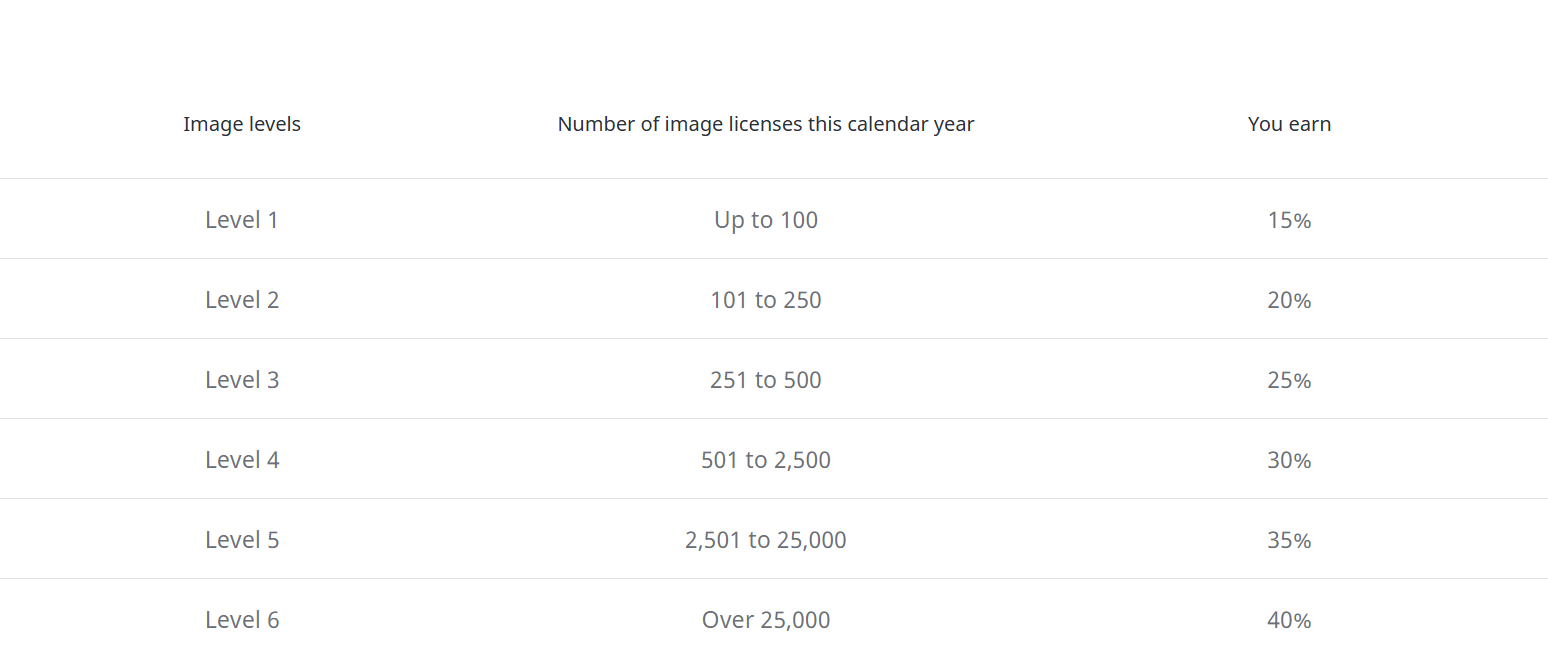Hey there! If you’re a musician or a composer looking to get your music out into the world, you’ve probably heard of Shutterstock. While it’s famous for stock photos and videos, Shutterstock also offers a pretty cool platform for licensing music tracks. Their Music Licensing Program lets artists upload their songs and earn money whenever someone licenses their track. It’s a win-win — you get exposure and income, and creators get access to a vast library of music for their projects. But understanding how payments work can feel a bit tricky at first. Don’t worry — we’re here to break down everything you need to know about
Factors Affecting Earnings from Music Tracks on Shutterstock

So, you’re curious about how much you can actually make from your music on Shutterstock? The truth is, your earnings aren’t set in stone — they depend on several factors. Let’s walk through the main ones:
- Type of License: Shutterstock offers different licensing options — Standard and Extended. Standard licenses are more common and cheaper for buyers, which means lower royalties for you. Extended licenses are pricier and bring higher payouts. So, the kind of license purchased directly impacts your earnings.
- Track Popularity and Demand: Just like with anything, the more popular and in-demand your track is, the more likely it is to be licensed repeatedly. Tracks with a broad appeal or trending genres tend to generate more sales.
- Pricing Structure: Shutterstock has a tiered pricing model based on the buyer’s subscription plan or one-time purchase. The higher the price paid by the licensee, the better the royalty rate you earn.
- Contributor Level: While Shutterstock doesn’t explicitly mention a contributor level system for music, your overall portfolio size and activity can influence your visibility and, potentially, your earnings.
- Geographic Location of Buyers: Sometimes, licensing rates vary depending on where the buyer is located, which can influence your payout.
- Usage Type: Background music, commercials, YouTube videos, films — different usages might have different royalty rates or licensing fees, impacting your total earnings.
In essence, the more you understand these factors, the better you can tailor your music to fit the platform and maximize your income. Keep creating, stay informed, and watch how your tracks perform on Shutterstock’s marketplace!
How Much Does Shutterstock Pay for Music Tracks
If you’re wondering whether contributing music to Shutterstock is worth your time, understanding the payment structure is key. Shutterstock offers a straightforward licensing model, and your earnings depend largely on the type of license purchased and your contributor level.
So, how much can you actually make? Well, the payout per track varies, but here’s a general idea:
- Standard License: Typically earns you between $0.25 to $0.50 per download.
- Enhanced License: Usually pays more, around $0.75 to $1.50 per download, depending on the track’s popularity and length.
Keep in mind that these are average figures, and your actual earnings will depend on several factors:
- Contributor Level: Shutterstock has a tiered system—Standard, Enhanced, and Premium. Higher tiers often lead to higher payouts.
- Track Popularity: The more your track is downloaded, the more you earn overall. Building a portfolio of versatile, high-quality tracks can boost your sales.
- Type of License: As mentioned, standard licenses are less lucrative than enhanced or extended licenses.
Additionally, Shutterstock offers a royalty-based model, meaning you earn a percentage of each sale rather than a fixed amount. The exact percentage depends on your contributor level and the type of license sold. For example, premium contributors might earn up to 30-40% of the sale price.
It’s also worth noting that Shutterstock pays out monthly, so you’ll receive your earnings once your account reaches the minimum payout threshold, which is typically around $35.
Overall, while the earnings per individual track might seem modest, consistent uploads and building a strong portfolio can lead to a steady stream of income over time.
How to Maximize Your Earnings as a Music Contributor
If you’re serious about making the most out of your music contributions on Shutterstock, there are several strategies you can adopt to boost your earnings and stand out from the crowd.
1. Focus on Quality and Versatility
High-quality, professionally produced tracks are more likely to be licensed. Make sure your music is well-mixed, free of background noise, and mastered properly. Offering a variety of genres and moods increases your chances of matching client needs.
2. Optimize Your Metadata
Think of metadata as the label that helps buyers find your tracks. Use descriptive, accurate titles, tags, and categories. Include relevant keywords such as genre, mood, instruments, and potential uses. This improves discoverability and can lead to more downloads.
3. Keep Uploading Consistently
The more tracks you upload, the higher your chances of earning. Regular uploads also signal activity to Shutterstock’s algorithm, which can favor your portfolio in search results.
4. Study Market Trends
Pay attention to what’s popular in the licensing market. For example, corporate background music, relaxing ambient tracks, or energetic tunes for fitness content are in demand. Creating tracks that meet current trends can give you an edge.
5. Engage with the Community
Join forums, social media groups, or contributor communities. Sharing tips, feedback, and insights can help you refine your craft and discover new opportunities.
6. Promote Your Work
While Shutterstock’s platform is the main marketplace, consider sharing your music on your own social channels or website. Building a personal brand can attract more clients and licensing opportunities beyond Shutterstock.
Remember, patience is key. Building a successful music portfolio on Shutterstock takes time, but with dedication and smart strategies, you can turn your passion for music into a steady income stream.
Tips for Uploading Successful Music Tracks to Shutterstock
Uploading your music tracks to Shutterstock can be an exciting opportunity to share your creativity and earn revenue. However, to maximize your chances of acceptance and sales, it’s important to follow some best practices. Here are some helpful tips to ensure your submissions stand out and meet Shutterstock’s standards.
Understand the Requirements
First and foremost, familiarize yourself with Shutterstock’s submission guidelines for music tracks. They typically require high-quality audio files in specific formats (like WAV or MP3), clear and professional metadata, and proper licensing documentation if applicable. Reading their contributor resources thoroughly will save you time and prevent rejection due to technical issues or incomplete information.
Focus on Quality and Clarity
Your music should sound polished and professional. Use good recording equipment, eliminate background noise, and ensure your tracks have a balanced mix. Remember, Shutterstock caters to a wide range of projects, so tracks that are clean, well-mixed, and free of distortion tend to perform better.
Create Versatile and Appeal-Driven Tracks
Think about what buyers might need. Tracks that are versatile, neutral, and instrumental often perform well because they can fit into various projects—be it corporate videos, ads, or apps. Consider creating multiple versions or edits of your tracks to give buyers more options.
Use Accurate and Descriptive Metadata
Metadata is key to making your music discoverable. Use clear, descriptive titles, genres, moods, and keywords that genuinely represent your tracks. Avoid keyword stuffing; instead, focus on relevant terms that accurately describe your music’s style and emotional tone.
Maintain Consistency and Regular Uploads
Building a portfolio takes time. Regularly uploading new tracks not only increases your chances of making sales but also helps you stay visible on the platform. Consistency shows Shutterstock that you’re an active contributor, which can positively influence your ranking in search results.
Engage with the Community and Learn from Feedback
Participate in forums or groups where Shutterstock contributors share tips and experiences. Pay attention to any feedback or rejection reasons provided by Shutterstock, and use that information to improve your future submissions. Continuous learning and adaptation are vital to success.
Conclusion and Final Thoughts on Shutterstock Music Revenue
Getting your music tracks onto Shutterstock is a fantastic way to monetize your creativity and reach a global audience. While the earning potential varies depending on the quality, popularity, and demand for your tracks, many contributors find it to be a steady source of income over time. Remember, understanding Shutterstock’s payment rates and how they are calculated can help you set realistic goals and optimize your strategies.
To maximize your revenue, focus on creating high-quality music, following submission guidelines, and staying consistent with your uploads. Pay attention to market trends and buyer preferences, and don’t hesitate to experiment with different styles and genres. Over time, as you build a robust portfolio and gain experience, you’ll likely see your music sales grow.
In the end, success on Shutterstock isn’t just about quick earnings—it’s about building a sustainable and enjoyable creative business. Keep refining your craft, stay informed about platform updates, and most importantly, enjoy the process of sharing your music with the world. Happy uploading!

